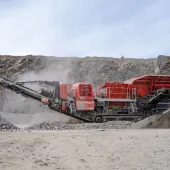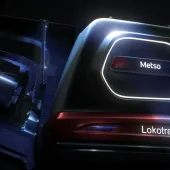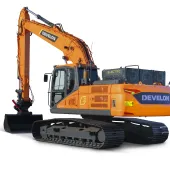Next-level Dual-Power crushers from Screencore
New XJ and XL Dual-Power jaw crushers said to deliver increased fuel efficiency and lower emissions
FROM the start Screencore have produced a range of compact and modern mobile crushing, screening, and stockpiling equipment, purpose built using the most up-to-date manufacturing techniques. Now the company has updated its range of Dual-Power tracked jaw crushers to offer increased levels of fuel efficiency and lower emissions, but with the same highly productive features.
Screencore’s next-level tracked XJ and XL Dual-Power jaw crushers have been developed to provide users with mobility, productivity, efficiency, and crushing performance. In line with the company’s design philosophy, the Dual-Power machines come packed with a range of user-friendly features designed to deliver high throughputs, low cost per tonne production, and accurate reduction. At their heart, however, is Dual-Power functionality.
‘All our models are available in Dual-Power format, which has several distinct advantages over traditional diesel/hydraulic crushers, not least of which is a miserly fuel consumption in single-digit litres/h. Environmentally, both the XJ and XL tick all the boxes, including both the ‘Zero Emissions’ box, thanks to their plug-in ability, and the ‘Low Noise’ box. We also believe that they raise the productivity bar substantially for their crushing class,’ explained Screencore director Ciarán Ryan.
To reduce CO2 emissions and fuel consumption even further, Screencore have optimized machine efficiency to deliver higher output with less wear and improved fuel efficiency. The newly updated Dual-Power crushers are now fitted with what the company believes are the most efficient and flexible electric and hybrid drive systems on the market, and which deliver low energy consumption due to the drive system and design.
These flexible electric drive systems mean the Dual-Power crushers can be connected directly to the mains or, alternatively, be powered by a drop-off diesel/genset unit when there is no access to the electricity grid. When connected to the grid, CO2 emissions depend on the power source. If the power is obtained from fully renewable energy, production is completely carbon neutral. When using the diesel/generator unit, fuel savings of 50% are said to be still achieved compared with conventional diesel hydraulic crushers.
The backup diesel/genset unit can generate enough electricity to power multiple Dual-Power machines, such as the Screencore range of Trident scalpers or stackers. This means that twice the power can be supplied via the plug-out connection. When working in production trains, attributable fuel consumption is said to decrease by up to 70% when the scalpers and stackers are directly powered. When connected to the grid, the savings are significant (depending on the local electricity price) as both operational and maintenance costs will drastically be reduced because no diesel engines are used. Also, no oil is used in this case and no filters need to be replaced.
Screencore say they intend to add to their range of Dual-Power crushers, screens, and stockpilers, and will continue to offer the Dual-Power functionality for all their product offerings. ‘At Screencore, we are dedicated to driving innovation with a focus on sustainable practices. We aim to not only enhance operational flexibility for our customers, but also contribute to environmental preservation and provide customers with real choice,’ said Mr Ryan.
‘The intelligent integration of the Dual-Power range can be extended to other crushers or screens (including suitably equipped equipment from other manufacturers) with spare electrical capacity, eliminating the need for an extra engine and significantly contributing to carbon reduction. The Dual-Power functionality is an environmentally focused, flexible, and efficient solution that is bringing the future here now. It will help transform how crushing and screening trains work, bringing enormous environmental benefits, efficiency, productivity, and operating cost reductions.’










